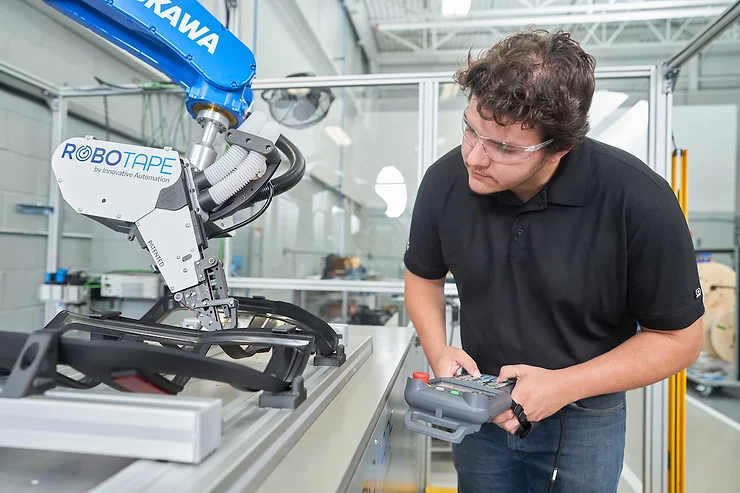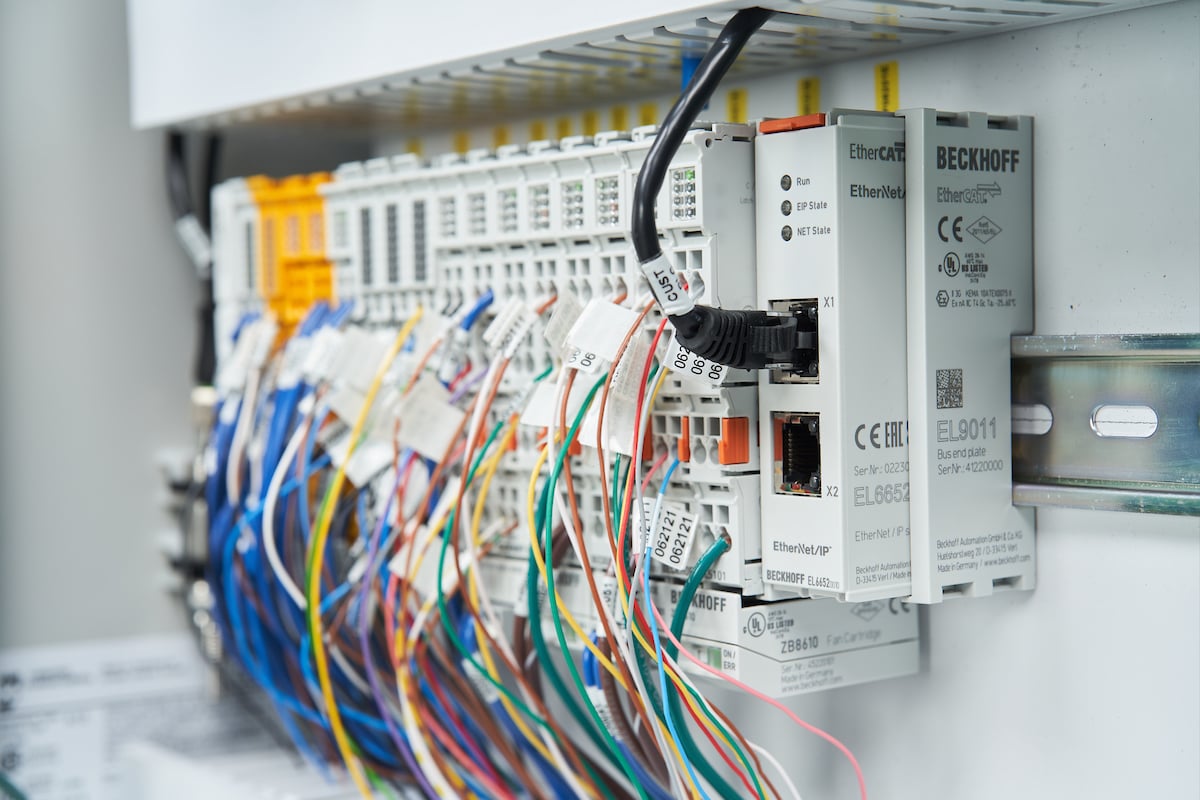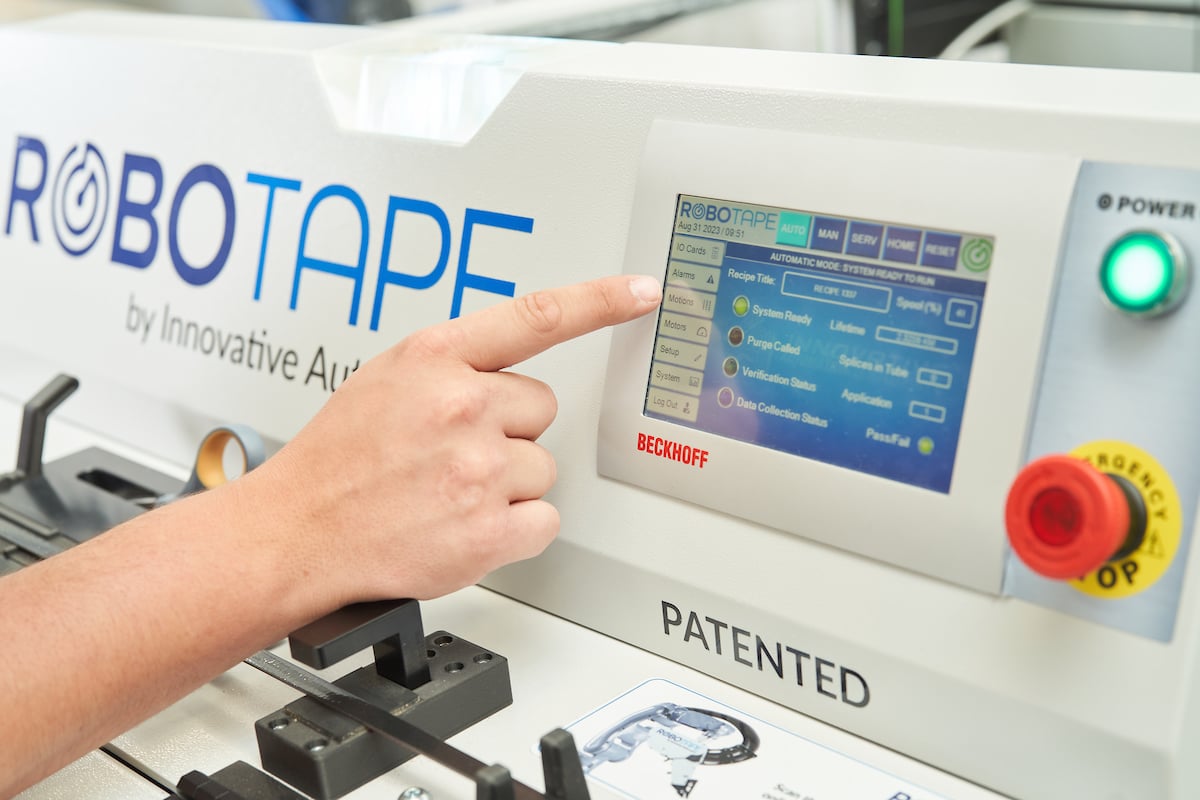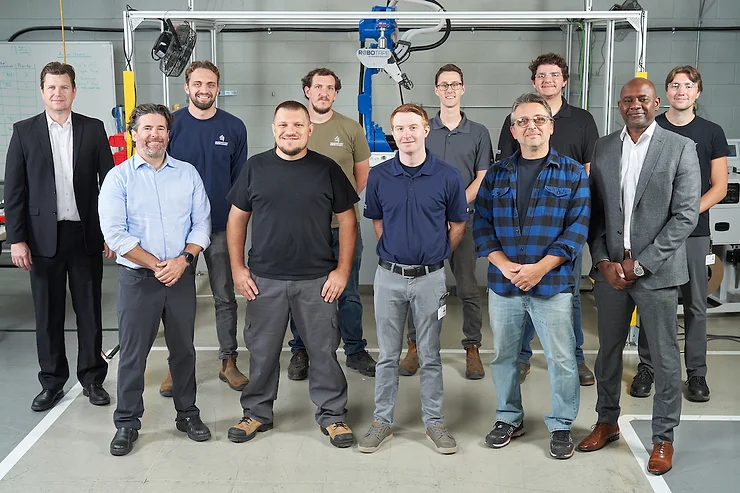.png?width=76&height=76&name=Untitled%20(100%20x%20100%20px).png)
It’s a sticky situation. The world of adhesives keeps expanding to accommodate even broader applications with highly tailored tapes, foams and other products. However, automated tape dispensing systems have not kept up and offer little flexibility to adapt to wide-ranging industry requirements. Here, RoboTape has staying power.
Innovative Automation, a custom machine builder and systems integrator headquartered in Barrie, Ontario, developed the RoboTape platform. Leveraging advanced robotics and flexible controls technology, RoboTape delivers a fast, flexible and scalable tape dispensing solution suitable for everything from B2B industrial applications to large CPG companies.
“Innovative Automation started in 1989 with three founding partners and grew over the years by providing custom automation integration services, primarily to Tier 1 automotive manufacturers,” says Michael Lalonde, Co-owner and President of both Innovative Automation and RoboTape. “After three decades of success with custom automation solutions, we formed an R&D department to develop standard automation products. In the past we had built a number of specialized taping systems, and this experience gave us the idea to create a more flexible solution, which eventually became RoboTape."
The RoboTape business unit in Newmarket, Ontario, now offers solutions to customers around the globe. One such offering is the compact, stand-alone “RoboTape Lite” work cell. It provides a low-cost and quick-to-integrate entrance to automated taping technology.

The RoboTape system offers a scalable, automated solution for applying industrial adhesive tapes.
The next step up is the RoboTape standard cell with an enclosed industrial robot for high production throughput. The impressive capabilities led to a collaboration with 3M, a global leader in industrial bonding solutions, and the development of another offering – the RoboTape™ System for 3M™ Tape.
Customers can buy the RoboTape system for installation by a preferred integrator or work directly with Innovative Automation for further value-added services. Either way, end users receive full support. The system suits all sorts of part geometries and adhesive types, and RoboTape engineers are eager to prove it.

The RoboTape’s remote feeding system allows operators to change spools without entering the robot cell, eliminating potential hazards.
“We have set up a dedicated lab and test cell to run production intent trials with customer adhesives and parts. This testing allows RoboTape and the customer to be confident that cycle times and application requirements can be met before committing to a project,” says Zac Cutt, Research and Development Group Leader at Innovative Automation. “This service helps to alleviate any hesitancy to adopting a new technology.”
Peeling away common challenges
The experts at RoboTape and Innovative Automation are no strangers to problem solving. During the system’s design phase, they identified multiple mechanical and electrical engineering shortcomings of existing options. These were all opportunities to be, well, innovative.
The main pain point was robot size and maneuverability. Most systems place the tape spool at the end of the robot arm, along with an empty spool to catch the waste liner. Also, operators have to wait until the systems run out of tape, put them into a safe state, and enter the cell to add more.
“We came up with the idea of a remote feeding module that positions the spool outside of the work cell. That’s now patent pending worldwide,” Cutt says. “It also helps with the robot sizing issue, allows for larger spools and increases system uptime. This is why big automotive clients are latching onto it, it's currently the only solution that actually solves the entire problem.”
What's the difference between PC and PLC controls?
Get your free white paper debunking misconceptions about PC-based control vs PLC.

RoboTape can take on complex geometries using its highly maneuverable and compact application head.
The RoboTape system catches and chops up the waste liner at the remote feeding module. The design optimizations drastically reduce the size of the robot needed, Lalonde explains: “We were aiming for the 10-kilogram robot class, so keeping the applicator tool light and compact was a top priority. This allows the tool to work in tighter areas and to reduce the overall size and cost of the work cell. These are all things our customers have been requesting.”
Before RoboTape was ready for prime time in tape dispensing, a variety of challenges had to be removed first. The team had to effectively accommodate a wide range of robots, continuously adapt to new parts for taping processes and gather massive amounts of sensor data for rapid processing. All these demands ultimately led the R&D team to PC-based control.
RoboTape adheres to New Automation Technology
“In 2020, we created a decision matrix comparing four control system providers,” Cutt recalls. “We compared all of the technologies offered, the benefits, the price, etc., and ultimately, we decided that Beckhoff provided the best fit for the RoboTape system.”
As newcomers to Beckhoff, the engineering team was unfamiliar but excited to learn. Their day-to-day roles as custom machine builders lead to tackling new technologies, often with less support. Innovative Automation worked closely with the sales and support teams at Beckhoff Canada. Regional Sales Manager Paul Pierre and Application Engineer Jim Fallowfield offered advice and technical assistance on everything from TwinCAT 3 automation software programming to EtherCAT networking. This helped accelerate design, commissioning and operation.
TwinCAT offers an end-to-end engineering and runtime platform for all automation functionality from PLC, safety and motion control all the way up to IoT, machine learning and simulation. With support for all IEC 61131-3 programming languages and their object-oriented extensions, preloaded or custom function blocks, and computer science standards in Microsoft Visual Studio®, engineers can choose the best options based on their skillsets or, better yet, based on each application’s needs.

Regional Sales Manager Paul Pierre (left) and Application Engineer Jim Fallowfield of Beckhoff Canada
Sean Robillard, Controls Department at RoboTape, appreciated this comprehensive software approach: “With a TwinCAT project, we have one folder with files for each PC-based controller. Within that code, we have all safety and I/O, so development of the system can be easily managed. This helps us implement different recipes, which tell the system how much tape to dispense, how quickly, etc.”
A CP6706 economy built-in Panel PC offers ample processing power for the application. RoboTape amped up the standard model with a dual-core Atom® processor, 1-second uninterruptible power supply (UPS), 4 GB RAM and 40 GB Cfast card. The controller includes a 7-inch touchscreen for operator interface and is ready for cloud connectivity right out of the box.
“The user can view all their inputs and outputs, toggle cylinders, lights and sensors, and adjust other aspects of the machine,” says Josh Vander Doelen, Project Manager at RoboTape. “That’s all bundled into the same TwinCAT package, so it speeds up engineering and keeps the HMI design clean.”


.png?width=1200&height=800&name=Untitled%20design%20(20).png)
The system utilizes the EtherCAT industrial Ethernet system for communication to the robot and other field devices. EtherCAT offers real-time speeds, flexible topology and up to 65,535 nodes on a single network, and it’s also incredibly open to integrating with other protocols. Beckhoff offers I/O hardware for more than 30 industrial protocols, including EtherNet/IP, PROFINET and others, which helps the RoboTape team connect a vast range of robots and third-party devices such as sensors and encoders in customer facilities.
“For example, we use many IO-Link sensors to gather as much data as possible,” Cutt adds. “We simply add EL6224 IO-Link terminals from Beckhoff to the main I/O segment as we need more sensors. Now we can gather a significant amount of data about the machine from the different sensors and analyze them for actionable insights.”

The PS power supply series from Beckhoff reliably delivers power for the RoboTape automation system.
With the TwinSAFE integrated functional safety system, the RoboTape platform can best protect plant personnel and equipment. The remote feeding module can enter a safe state when operators open its enclosure. A cutting blade utilized to chop the spent liner and other pinch points contained inside require guarding and protection. TwinSAFE offers safe inputs and outputs that integrators can connect directly to the door of the robot cell, light curtains or floor mats, for example.
TwinSAFE incorporates Safety over EtherCAT (FSoE) to communicate over standard networks using a “black channel” approach. Safety data can travel over the same EtherCAT network, ensuring the necessary cable redundancy with no hardwiring between safety devices. Added to the list of Beckhoff technologies, TwinSAFE further simplifies design, commissioning and operation.
RoboTape helps manufacturers out of sticky situations

The engineering experts at Innovative Automation and Beckhoff stick together at the RoboTape facility in Newmarket, Ontario: (back row, from left) Jim Fallowfield (Beckhoff) with the Innovative Automation team of Josh Vander Doelen, Sean Wilson, Sean Robillard, Quinton Potts, Carter Metcalf, (front row) Michael Lalonde, Mike Likernyy, Zac Cutt, John Marinuzzo and Paul Pierre (Beckhoff).
With all these technological developments, RoboTape has quickly gone global. In addition to the unique robotic system developed for 3M, Innovative Automation has entered partnerships with distributors worldwide to handle increased demand for sales and service in other countries. These ongoing results continue to impress even the R&D team that created the system.
“Our systems average eight hours of runtime before refills, but this can be greater depending on the material,” Cutt says. “For instance, one customer processed 14,000 feet of felt on a single spool, so they're making enough parts for about 2,000 cars a day and only changing spools once a week."
Another Tier 1 automotive supplier shrank the overall footprint of its assembly area by removing two manual taping stations. In addition, it reduced labor requirements at a time when job openings remain difficult to fill. As a result, the customer saved roughly $225,000 per year on adhesive applications in one plant. To date, the RoboTape systems in the facility have processed more than one million automotive parts with only basic maintenance.

Unlike most robotic tape dispensing systems, RoboTape doesn’t carry the adhesive tape spool on the end of the robot arm.
Flexible PC-based control from Beckhoff enables the systems to adapt to new products and send data to higher-level systems as needed. Soon, RoboTape will roll out an optional data collection system to enable users to monitor system data from a dashboard.

A Beckhoff CP6706 offers machine control and an intuitive operator interface for pulling up recipes and toggling functions.
“Our new IoT capabilities can allow us to see which machine modes are activated and for how long. So if a system is in service mode for long periods of time, it could indicate it needs maintenance or that a particular operator requires more training to meet uptime goals,” Cutt says. “We can see the machine’s overall equipment effectiveness (OEE), along with metrics like internal and ambient temperature, to continue to optimize and improve reliability.”
Innovation, not surprisingly, is a core value at Innovative Automation. However, it was vital for Lalonde and the team to select automation technology that was not just on the cutting edge but also supported worldwide as the company expands.
“That consistent global support and availability are reasons why Beckhoff has proven to be a great choice, and we’re excited to continue working together in the future,” Lalonde says. “Innovative Automation has always been a leader in the industry, and likewise, Beckhoff is constantly pushing the envelope with new technologies. That means we can keep reinventing how automation can maximize our customers’ success – no matter how challenging the application."
Ready to stick it to outdated industrial automation and controls technologies?
Contact your local Beckhoff sales engineer today.
.png?width=550&height=275&name=You%20may%20also%20like%20(2).png)

.png?width=1000&height=500&name=Untitled%20(1000%20%C3%97%20500%20px).png)